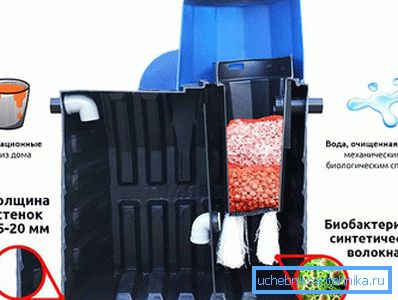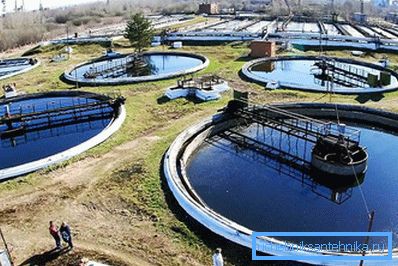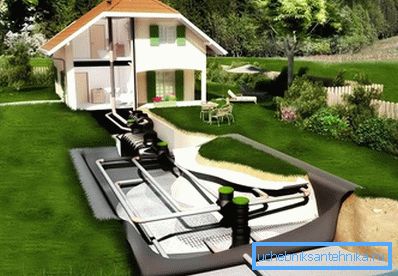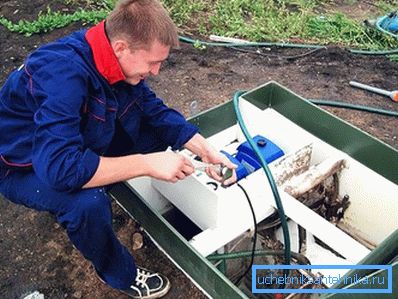Local sewage treatment
In the modern world, a variety of technologies are used that can significantly improve the lives of people. One of such systems is various local sewage treatment plants. Such devices and units are designed for sewage treatment. They are simply indispensable for country houses. In this article, we will talk about a system such as local sewage treatment and what devices are used in it.
Species

Very often, abbreviations such as LOS can be heard from workers in the communal sphere. If in a simple way, such devices are called local sewage treatment plants, and they form the basis of an autonomous sewage system.
Tip! Classic wastewater treatment plants operate on the principle of reducing the flow rate of wastewater. As a result of the fall in velocity, the solid particles settle to the bottom, and the remaining impurities are subsequently removed with the help of after-treatment devices.
In order for a classic sewage treatment plant to cope with its task, it is necessary to correctly select the volumes of tanks that will be drained. According to certain calculations carried out by experts, one person consumes up to 200 liters of water per day. This means that the number of “generated” stocks is the same.
For a classical cleaning system, it is necessary that the drains are allowed to settle for several days. Therefore, the capacity should be large, and it is very difficult for private houses. That is why in the autonomous sewer systems the classic method of wastewater treatment is not used.
VOCs are designed for sewage treatment from private houses, summer cottages or a small village. Where there is no possibility to connect to a centralized sewer system, suburban real estate owners are building autonomous devices. These include the following facilities:
- septic tanks;
- aerotanks;
- biofilters.
Tip! Each of these structures has its own characteristics and the area of the most efficient use. But besides the VOCs themselves, filtering devices must be included in the autonomous sewage system. Only in this case it is possible to approach the level of wastewater treatment at 98–100%.
Septic tanks

Very often, when speaking of the autonomous sewage system, the owners of country houses recall such treatment facilities as septic tanks. Such devices are plastic (sometimes there are other materials, especially if the septic tank was made independently) capacity or several containers.
The choice of plastic as a material for tanks is determined by its positive characteristics:
- ease of construction, which greatly facilitates transportation and installation;
- easily tolerates exposure to aggressive media;
- does not give in to corrosion;
- has sufficient strength.
Inside each tank are several sections, each of which performs its task. Some sections play the role of a settler, in others, wastewater is treated with the help of colonies of microorganisms, in the third - filtration, etc.
Septic tanks are most often found in local wastewater treatment plants for the home. This popularity is due to ease of operation and long term use (according to manufacturers up to 50 years). At the same time, such devices can be both completely autonomous and dependent on the supply of electricity.
Tip! In most cases, to increase the degree of purification, the septic tanks are additionally equipped with aeration or filtration fields. But there are models that are called stations of deep biological treatment, which are able to independently clean the drains to almost 100%.
Aero tanks

Such devices are most often found in large wastewater treatment plants that process wastewater from large enterprises or localities. They are large tanks where water is mixed with activated sludge using oxygen. If we are talking about autonomous systems of private houses, then aero tanks are more modest in size and are most often mounted in septic tanks or other VOCs.
Tip! Quite often, aerotanks are equipped with special catchers. Such additional equipment helps to clean sewage from petroleum products, grease and other floating substances. These catchers, as a rule, are equipped with aerotanks operating at large sewage treatment plants.
Biofilters

Besides aerotanks and septic tanks in local treatment systems, biofilters can be used. Most often, they are part of LOS. Self biofilters are rarely used. Such devices produce wastewater treatment with the help of microbial colonies.
Tip! Bacteria in an aquatic environment saturated with oxygen or without air access decompose all impurities in the effluent. As a result, water is obtained at the outlet, containing only simple substances that do not harm the environment.
Cleaning steps in VOC

Getting into the local sewage treatment plant, sewage flows through several stages. As a result of each of them, the effluent is cleared of certain pollutants.
Consider these stages based on the most common VOC, which are most often used in autonomous sewer systems - a septic tank. Getting into such a device, the drains pass through:
- Mechanical cleaning. At this stage, the effluent is freed from solid and coarse fractions. Most often this occurs in tanks called a septic tank. Here the heavy and solid fractions precipitate. After accumulating a certain amount of them, sewage is pumped out using a fecal pump or an assenizator machine.
- Biological cleaning. This stage can be considered the most important. In special tanks, cleaning is carried out with the help of colonies of microorganisms. This process can occur without access to atmospheric oxygen. In this case the septic tank does not need connection to power supply networks. If microorganisms living in an oxygen environment take part in the work, compressors are used to supply air from the atmosphere. In this case, the septic tank is considered volatile.
- Aftertreatment After passing through several chambers (septic tank and biological treatment section), sewage is considered not fully cleaned. To remove from them the remains of sewage it is necessary to equip the system of after-treatment. As a rule, aeration or filtration fields are used as such. In the first case, the drains are poured into special open fields of a rather large size, the work of microorganisms continues here, but in a natural environment. To save space, a country autonomous sewage treatment system can be equipped with filtering devices. In this case, drains from the septic tank fall into ditches or pits filled with rubble or other solid fillers with large fractions.
Tip! If you use biological treatment stations on your site, then the principle of their operation is similar to a septic tank. The only significant difference is the absence of aeration or filtration fields.
Service recommendations

Since septic tanks are most often used in autonomous sewage treatment systems for a private house, you should familiarize yourself with the recommendations for their use:
- Treatment facilities equipped with devices such as airlifts operate more efficiently. With their help, activated sludge is not “released” from the septic tank, but remains inside. As a result, cleaning takes place more efficiently and does not require additional “colonization” of microbial colonies.
- The amount of activated sludge may be unnecessary. So that the septic tank does not overfill, it is better that it is equipped with an aerobic stabilizer.
- The activated sludge itself is an excellent fertilizer for garden and garden plants. Therefore, you can significantly save money without causing a vacuum truck, but by pumping yourself directly to the beds.
- In order for cleaning to take place efficiently, the death of microorganisms must not be allowed. To avoid this, try not to “flush” various poisons, chemicals and aggressive substances into the autonomous sewage system. It is also not recommended to use detergents containing chlorine. This element is poisonous for most species used in septic tanks of microorganisms. In addition, you should not flush the contents of the filters from the washing vacuum cleaners into the toilet.
- Since solid contaminants accumulate in the septic tank, they should not be allowed to enter sewers. After all, this will lead to an increase in your operating costs.
- Periodically conduct a visual inspection of the septic tank. It is worth remembering that even though such facilities have a fairly simple device, yet they can sometimes break.
If you follow these recommendations and follow all instructions, then VOC will serve you for more than a decade. Maybe you have questions on the topic? Ask them to an expert working on the site. Have a desire to share personal experience? Write a comment on the article.
We recommend:
device drainage on the site with their own hands.
Video
In the videos provided, you can get more information about local sewage treatment: